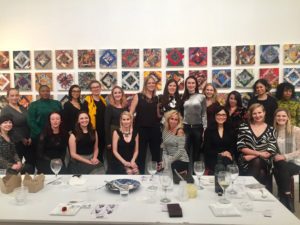I remember presenting about women’s philanthropy at a general fundraising conference in 2012. I felt deflated after the session ended. First – there were only 20 people in the room set for 75, when other tracks had people spilling out the doors. This was an analog version of Facebook “likes” and my topic clearly wasn’t getting many! Second – the individuals in the room were scratching their heads. “Really, women give differently??” or “But women don’t really provide much support, right?” or “I’ve tried to connect with women, but they take too much of my time with all their questions and ideas.”
Little did I know that these early presentations were planting acorns. Fast forward to late March 2022 when I led the first-ever conference of Professionals in Women’s Philanthropy (PWP). We had 44 leaders in the room who had the mandate to grow women’s support for their institutions. Each was nodding, scribbling notes furiously, sharing successes, and offering ideas to their peers who were just beginning an intentional focus on women. They represented 38 institutions and their efforts have already raised hundreds of millions of dollars from women, along with demonstrable shifts in the number of women of all backgrounds in their leadership and donor pipelines.
What has changed in ten years?
Research, Proof of Concept and Principles
Research:
The Women’s Philanthropy Institute (WPI) at the Indiana University Lilly Family School of Philanthropy has provided more than a decade of deep research on how women approach their charitable support. Thanks to more than 125 unique data points affirming that gender matters in philanthropy as much as gender matters in health care and other domains, we can stand firmly on foundational knowledge that there is real power and potential in women’s philanthropy.
Proof of Concept:
In 2012, I counted fewer than 12 institutions which were intentionally investing in women’s philanthropy. In 2013, William & Mary started their focus and has been widely successful with their growth – one data point is that more women than men gave to their very successful For The Bold campaign which ended in 2021. Others started soon after, such as Dartmouth College with its well-known Centennial Circle plus the 100 women who each gave at least $1M each to their campaign. For a while one or two institutions would begin this journey each year. In 2022, I have fielded calls from 20 institutions in the first quarter alone. Everyone is seeing the successes, is calling each other to find out how to do this, and to be honest, is hearing from their women trustees and leaders asking why they AREN’T paying more attention to women.
Principles:
We now have six principles for successful and sustained women’s philanthropy. When I reviewed dozens of successful initiatives in women’s philanthropy today, vs efforts that sputtered and did not last from the past, I realized that consciously or not, each institution was instinctively following key principles – such as women’s input is key, gain leadership champions first, and women bring more than money. I realized THAT is why we are seeing today’s successes, so I began sharing these principles widely. You can read more about them here.
Working with previously unseen donors means we need principles to help us break away from current tactics that may not resonate with women. We need principles to awaken and guide us in designing new approaches to meet all diverse volunteers and donors as they prefer. Otherwise, we will keep doing what we’ve always done in the past and keep getting the same results, which includes missing all the women who are prepared and eager to give to the causes they choose.
Our March 2022 conference was built around these principles and the wisdom of the leaders in the room. Today’s Professionals in Women’s Philanthropy are proof that the little acorns planted a decade ago are growing into a mighty movement of women’s philanthropy.
Three new acorns grew out of our PWP conversations that will give further shape to the steadfast tree of women’s philanthropy as its roots take hold across the country: Definition of Philanthropy, Intersectionality, and Partnership.
Definition of Philanthropy
At the conference WPI Director Jeannie Sager shared with the group that:
“Our research shows that broadly defining the term “philanthropy” is key to engaging a diverse group of donors. Yes, it’s important to give money to charitable organizations. But there are so many generous activities, from using money differently (like impact investing or buying from companies with a social mission), to other activities like volunteering, sharing about causes, and advocating for certain organizations in your communities.”
The reframing of “philanthropy” that Sager references also relates to the 6 T’s: Trust, Time, Talent, Treasure, Ties and Testimony. I agree that it is critical to understand ALL the resources women often provide generously. It is not just respectful of women. It is also essential.
A broader definition of philanthropy matters because we are facing complex societal issues. Social and racial inequities have always been in our country. But now with increased understanding of deep-rooted inequities, there are clear expectations that nonprofits and higher ed must be part of the solutions our society needs.
To tackle this complexity, money is no longer enough – we need all types of resources to create lasting solutions. When we welcome in women and their broad definition of philanthropy, we gain so much more than one check for one goal. We know from research and our experience in the field that women strive to use their many resources to create systemic change for our institutions and society.
Intersectionality:
Sager stated that intersectionality, simply put, is the idea that people have overlapping identities – gender, race, class, etc. – and therefore different experiences in society. Intersectionality will continue to be a driving concept in women’s philanthropy moving forward, since overlapping identities affect people’s giving.
We recognize that women donors are not a monolithic block and understand that different women come to philanthropy with unique identities and experiences that shape where and how they give. At a recent women’s philanthropy advisory group for a college just beginning their intentional commitment to all alumnae, a woman said, “I’m black, queer and from the south and here are some things you want to consider.”
When we commit to connecting with women, we must also commit to design an inclusive community where all women see themselves reflected. It may take more time to tap into new networks and relationships, but greater diversity results in authentic, trusting communities digging in to create bolder impact for the causes they care about.
Partnership:
A core principle is that women’s input is key. We know women want to be engaged, learn, understand, and not just be asked for a gift. Women and nonbinary donors want to be seen as partners who have much to provide. This means they want to participate in understanding gaps and designing viable solutions. They expect to work in tandem with an organization to fulfill its mission.
To create sustained partnerships, we must continue to invite women in, ask their opinion, and really listen. I’ll admit that listening and co-creating with stakeholders can feel messy and out of step in a sector that moves fast, relies on proven tactics and is risk averse. We have perfected the art of tying things up with a bow for our volunteers and donors, so it can be unnerving to not know exactly what will happen next when we are working with a collective of women!
I’ve learned that we need to trust the process of this work. And we need to trust the women who care about our missions. It is from our partners – not our past practices – where we often discover what will lead to success. Trust the women and all they will do. Often, the women donors think more boldly and envision far more than staff had imagined possible! To share a framework I learned from the women of William & Mary, women Gather and empower each other to do more for the mission. They Grow leaders, networks, pipelines of more prospects for the mission. And they Give boldly, frequently in ways that catalyze others to join them.
After ten years of quiet, consistent focus, our growing community is changing the face of philanthropy, changing the definition of philanthropy, and changing HOW we engage with women and all donors who were previously unseen. As I look ahead, I believe that the three new acorns that grew from our conference will become strong oaks making philanthropy more inclusive. While our conference may have been about women’s philanthropy, ultimately it was about philanthropy’s role in societal change.






